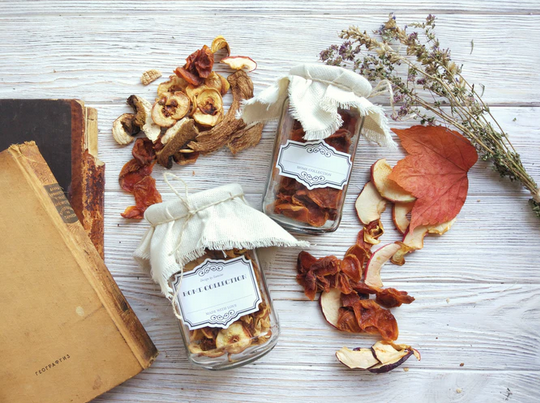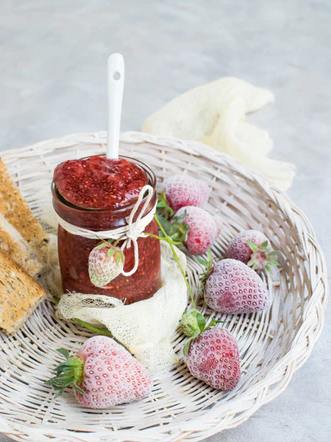The 5 food content marketing categories—and ideas—every food and beverage brand needs for their blog.

Food brands, your online presence is required!
Once upon a time, online food shopping was a niche market. These days, however, supercharged by the pandemic, it’s become increasingly common to shop for food products online—especially among Millennial and Gen Z consumers.
And we’re not just talking about specialty products that are otherwise hard to find in your local grocery store either. We’re talking grocery shopping and getting ready-to-eat meals, meal kits, and even pastry subscription boxes delivered. Food (in all its delectable forms), period.
And as consumers, it’s perfectly normal for us to research food and beverage (F&B) brands online. We like to look things up before making a purchase.
For example:
- “Best vegan chocolate chip cookie brands”
- “Dark chocolate brands for baking”
- “Is [brand name] coffee good?”
For direct-to-consumer food and beverage companies, this type of buyer behavior translates to a can’t-miss opportunity to nurture interest and potentially grow sales via food content marketing. More specifically, business blogging.

Readers are always hungry for more content and you need to deliver.
Taking pretty pictures and filming short snippets is one thing. But food content writing? Well, it sounds easy until you’re actually tasked with producing a consistent supply of high quality posts for your brand. Then it’s substantially less fun and a whole lot more stressful. (Blog topic ideas, anyone?)
But brainstorming blog content ideas isn’t your only concern. After all, the goal isn’t to churn out content just for the sake of food content marketing.
It’s about finding the right balance of blog posts that:
- grow awareness around your brand
- introduce products to your target segments
- convey brand values

Ultimately, you’re blogging because you want to build rapport, gain readers’ trust, win their support—and convert casual readers into paying customers.
Here are a few things to remember:
- Before you start writing, it helps to have a blog content strategy
- Create blog content for every stage of the purchase journey
- Search intent should be factored into your content marketing ideas
- You’ll need a healthy mix of timely and evergreen material
- Pay attention to topics of interest—it’s not always going to be about your products

Blog content for food and beverage businesses
Ultimately, you’re blogging because you want to build rapport, gain readers’ trust, win their support—and convert casual readers into paying customers.
#1: Requisite recipe and ‘alternative uses’ posts
Recipes, recipes and more recipes.
If you’re in the F&B industry, chances are you’ll be publishing quite a few of these as part of your food content marketing strategy.
Recipe posts don’t just work to highlight all the delicious ways your product can be used, served or enjoyed—they also stimulate desire. Think of the all-too-familiar “must try soon” feeling we get when we see tasty, mouth-watering creations on our screens!
Another spin on the recipe post is the ‘creative ideas’ post.
Here, you highlight innovative uses for your product. For example: by now, we all know baking soda isn’t just a raising agent for your baking adventures – it’s also great for removing odors, used for cleaning and so on. These types of posts can help with product positioning.

#2: “Connect with your audience” posts
F&B content marketing helps bridge the gap between you, as a business, and the consumer. In other words, you get to cultivate a relationship with your readers.
What kind of blog topics can help you do that?
- A behind-the-scenes look at your business
Whether that’s product development, ingredient sourcing, the marketing team or beyond, show readers what it’s like to work at your company. - One-on-one interviews
That could be with your founder (ahem, that’s probably you), team members, business partners (retailers, suppliers) or the influencers you work with. - Feature your customers
There are many ways you can make your readers feel special and appreciated. Invite them to share their original recipes or create a weekly round-up of the best photos shared on Instagram using your unique hashtag. - Get readers involved
Interacting with customers and getting their feedback is valuable. On the flip side, it makes them feel respected. Content might include polls or asking readers what they want to see from you.
For example: If you make chocolates, you might publish a “If I were [brand]’s chocolatier, I’d make…” and ask readers to submit their whimsical ideas.

#3: Educational posts
This type of food content marketing addresses consumers’ informational search intent. In short, the aim here is to educate.
These blog posts are particularly handy when you want to build awareness. Why? They allow you to introduce your brand naturally – casually – without coming across like an overly pushy salesman.
Informative content might include:
- How-to posts and tutorials
For example: “How to brew loose leaf tea perfectly” - Q&A posts
For example: “What is pea milk?” - Origin, history or tradition posts
For example: “A brief history of soy sauce” - Myth busting posts
For example: “Does tea expire or go bad?” - Interesting facts or useful information
For example: “When to use pink peppercorns in your cooking”
Did you know?
Check out these exciting findings:
- People are more than 2x as likely to buy from a brand after reading educational content on their blog.
- After reading a brand’s educational content, consumers are 131% more likely to immediately make a purchase from them and 48% more likely to buy from the brand that educated them even one week later.
- Preference for the brand increases with readers’ perception of “trustworthiness” increasing by 9% (from 64% to 73%) and positive views increasing by 8% from 66% to 74% a week after reading educational content.
Source: Conductor

#4: News and updates posts
This is pretty self-explanatory. Your blog is a great place to share relevant updates with customers and prospects.
Content such as:
- A sneak peak at soon-to-launch products
- Product highlights
- Announcing new retailers that carry your brand
- Happy milestones
- Upcoming events or a rundown of recent event happenings

#5: Seasonal content posts
Christmas, Valentine’s Day, Mother’s Day, Father’s Day, Birthdays, Black Friday, Halloween, International Strawberry Day and whatever else exists in your part of the world – special events and traditional gift-giving occasions give F&B brands plenty to blog about!
Whether that be gift guides or other fun and even sentimental content for that time of the year, these types of blog content are the perfect companion for seasonal sales and promotions—and complement email marketing campaigns!
CONTENT CREATION TIP
It’s OK to go off-topic as long as you remain on-brand.
For example: if you sell premium frozen berries, there are only so many berry-focused topics you can write about before (1) you run out of useful material and (2) readers slowly run out of interest. So don’t be afraid to get creative and have some fun with your food content marketing—as long as it is content your customers would appreciate.
Which of these ideas will you be using next?
Also, in case you’re interested, check out the following pages for more content on the various topics mentioned in this post:
- Where to start with your blog content strategy
- Stages of the purchase journey and the content that works best
- Online shopping statistics you need to know
- What you need to know about search intent
- Why you should hire a content writer
Happy reading!